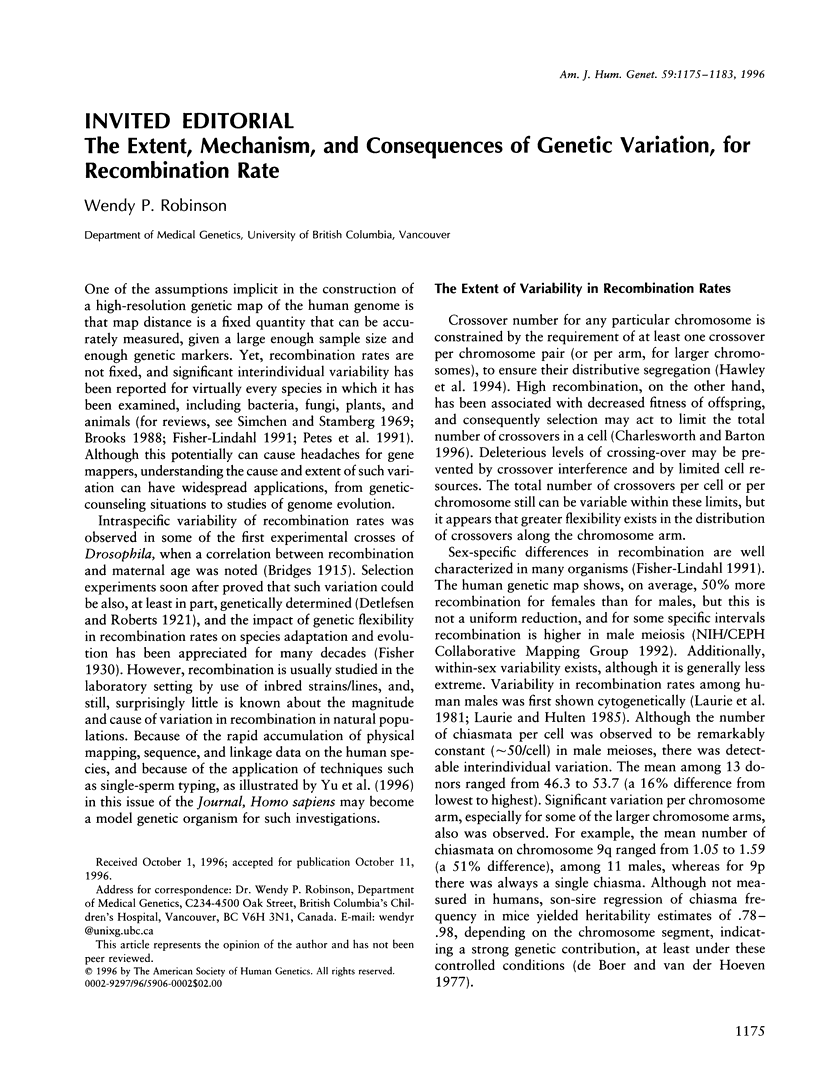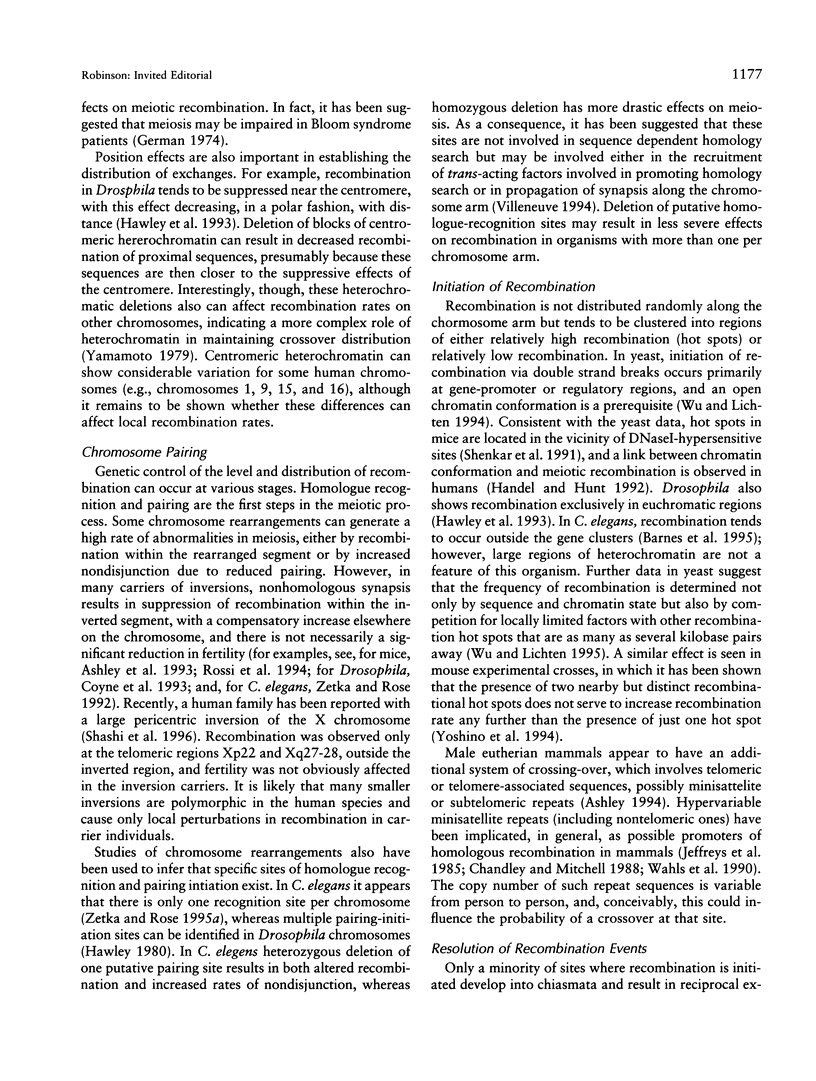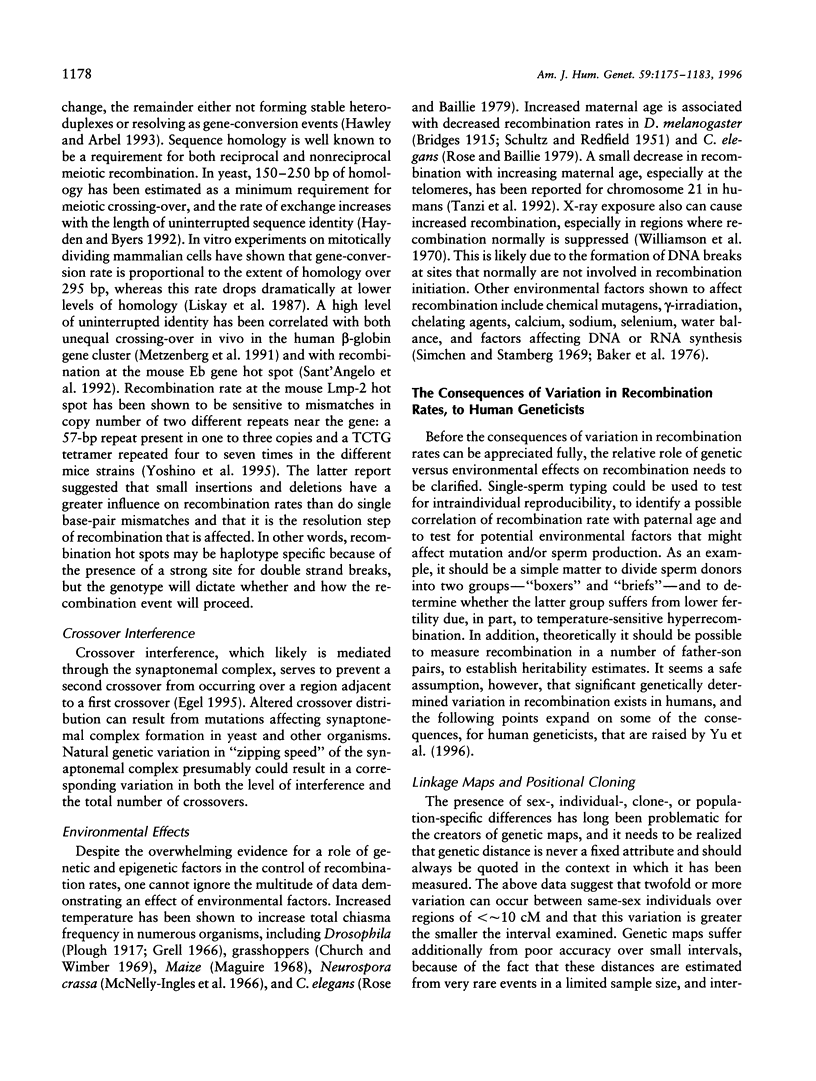Full text
PDF








Selected References
These references are in PubMed. This may not be the complete list of references from this article.
- Ashley T., Cacheiro N. L., Russell L. B., Ward D. C. Molecular characterization of a pericentric inversion in mouse chromosome 8 implicates telomeres as promoters of meiotic recombination. Chromosoma. 1993 Jan;102(2):112–120. doi: 10.1007/BF00356028. [DOI] [PubMed] [Google Scholar]
- Ashley T. Mammalian meiotic recombination: a reexamination. Hum Genet. 1994 Dec;94(6):587–593. doi: 10.1007/BF00206950. [DOI] [PubMed] [Google Scholar]
- Baker B. S., Carpenter A. T., Esposito M. S., Esposito R. E., Sandler L. The genetic control of meiosis. Annu Rev Genet. 1976;10:53–134. doi: 10.1146/annurev.ge.10.120176.000413. [DOI] [PubMed] [Google Scholar]
- Barnes T. M., Kohara Y., Coulson A., Hekimi S. Meiotic recombination, noncoding DNA and genomic organization in Caenorhabditis elegans. Genetics. 1995 Sep;141(1):159–179. doi: 10.1093/genetics/141.1.159. [DOI] [PMC free article] [PubMed] [Google Scholar]
- Brooks L. D., Marks R. W. The organization of genetic variation for recombination in Drosophila melanogaster. Genetics. 1986 Oct;114(2):525–547. doi: 10.1093/genetics/114.2.525. [DOI] [PMC free article] [PubMed] [Google Scholar]
- Buetow K. H., Shiang R., Yang P., Nakamura Y., Lathrop G. M., White R., Wasmuth J. J., Wood S., Berdahl L. D., Leysens N. J. A detailed multipoint map of human chromosome 4 provides evidence for linkage heterogeneity and position-specific recombination rates. Am J Hum Genet. 1991 May;48(5):911–925. [PMC free article] [PubMed] [Google Scholar]
- Chandley A. C., McBeath S., Speed R. M., Yorston L., Hargreave T. B. Pericentric inversion in human chromosome 1 and the risk for male sterility. J Med Genet. 1987 Jun;24(6):325–334. doi: 10.1136/jmg.24.6.325. [DOI] [PMC free article] [PubMed] [Google Scholar]
- Chandley A. C., Mitchell A. R. Hypervariable minisatellite regions are sites for crossing-over at meiosis in man. Cytogenet Cell Genet. 1988;48(3):152–155. doi: 10.1159/000132613. [DOI] [PubMed] [Google Scholar]
- Charlesworth B., Barton N. H. Recombination load associated with selection for increased recombination. Genet Res. 1996 Feb;67(1):27–41. doi: 10.1017/s0016672300033450. [DOI] [PubMed] [Google Scholar]
- Chinnici J. P. Modification of recombination frequency in Drosophila. I. Selection for increased and decreased crossing over. Genetics. 1971 Sep;69(1):71–83. doi: 10.1093/genetics/69.1.71. [DOI] [PMC free article] [PubMed] [Google Scholar]
- Church K., Wimber D. E. Meiosis in the grasshopper: chiasma frequency after elevated temperature and x-rays. Can J Genet Cytol. 1969 Mar;11(1):209–216. doi: 10.1139/g69-025. [DOI] [PubMed] [Google Scholar]
- Coyne J. A., Meyers W., Crittenden A. P., Sniegowski P. The fertility effects of pericentric inversions in Drosophila melanogaster. Genetics. 1993 Jun;134(2):487–496. doi: 10.1093/genetics/134.2.487. [DOI] [PMC free article] [PubMed] [Google Scholar]
- De Braekeleer M., Dao T. N. Cytogenetic studies in male infertility: a review. Hum Reprod. 1991 Feb;6(2):245–250. [PubMed] [Google Scholar]
- Egel R. The synaptonemal complex and the distribution of meiotic recombination events. Trends Genet. 1995 Jun;11(6):206–208. doi: 10.1016/s0168-9525(00)89046-0. [DOI] [PubMed] [Google Scholar]
- Esposito M. S., Ramirez R. M., Bruschi C. V. Recombinators, recombinases and recombination genes of yeasts. Curr Genet. 1994 Jan;25(1):1–11. doi: 10.1007/BF00712959. [DOI] [PubMed] [Google Scholar]
- Gabriel-Robez O., Ratomponirina C., Croquette M., Couturier J., Rumpler Y. Synaptonemal complexes in a subfertile man with a pericentric inversion in chromosome 21. Heterosynapsis without previous homosynapsis. Cytogenet Cell Genet. 1988;48(2):84–87. doi: 10.1159/000132595. [DOI] [PubMed] [Google Scholar]
- Grell R. F. The Meiotic Origin of Temperature-Induced Crossovers in DROSOPHILA MELANOGASTER Females. Genetics. 1966 Aug;54(2):411–421. doi: 10.1093/genetics/54.2.411. [DOI] [PMC free article] [PubMed] [Google Scholar]
- Griffin D. K., Abruzzo M. A., Millie E. A., Sheean L. A., Feingold E., Sherman S. L., Hassold T. J. Non-disjunction in human sperm: evidence for an effect of increasing paternal age. Hum Mol Genet. 1995 Dec;4(12):2227–2232. doi: 10.1093/hmg/4.12.2227. [DOI] [PubMed] [Google Scholar]
- Handel M. A., Hunt P. A. Sex-chromosome pairing and activity during mammalian meiosis. Bioessays. 1992 Dec;14(12):817–822. doi: 10.1002/bies.950141205. [DOI] [PubMed] [Google Scholar]
- Hari K. L., Santerre A., Sekelsky J. J., McKim K. S., Boyd J. B., Hawley R. S. The mei-41 gene of D. melanogaster is a structural and functional homolog of the human ataxia telangiectasia gene. Cell. 1995 Sep 8;82(5):815–821. doi: 10.1016/0092-8674(95)90478-6. [DOI] [PubMed] [Google Scholar]
- Hawley R. S., Arbel T. Yeast genetics and the fall of the classical view of meiosis. Cell. 1993 Feb 12;72(3):301–303. doi: 10.1016/0092-8674(93)90108-3. [DOI] [PubMed] [Google Scholar]
- Hawley R. S. Chromosomal sites necessary for normal levels of meiotic recombination in Drosophila melanogaster. I. Evidence for and mapping of the sites. Genetics. 1980 Mar;94(3):625–646. doi: 10.1093/genetics/94.3.625. [DOI] [PMC free article] [PubMed] [Google Scholar]
- Hawley R. S., Frazier J. A., Rasooly R. Separation anxiety: the etiology of nondisjunction in flies and people. Hum Mol Genet. 1994 Sep;3(9):1521–1528. doi: 10.1093/hmg/3.9.1521. [DOI] [PubMed] [Google Scholar]
- Hawley R. S., McKim K. S., Arbel T. Meiotic segregation in Drosophila melanogaster females: molecules, mechanisms, and myths. Annu Rev Genet. 1993;27:281–317. doi: 10.1146/annurev.ge.27.120193.001433. [DOI] [PubMed] [Google Scholar]
- Hayden M. S., Byers B. Minimal extent of homology required for completion of meiotic recombination in Saccharomyces cerevisiae. Dev Genet. 1992;13(6):498–514. doi: 10.1002/dvg.1020130611. [DOI] [PubMed] [Google Scholar]
- Heine D., Khambata S., Wydner K. S., Passmore H. C. Analysis of recombinational hot spots associated with the p haplotype of the mouse MHC. Genomics. 1994 Sep 1;23(1):168–177. doi: 10.1006/geno.1994.1474. [DOI] [PubMed] [Google Scholar]
- Himmelbauer H., Silver L. M. High-resolution comparative mapping of mouse chromosome 17. Genomics. 1993 Jul;17(1):110–120. doi: 10.1006/geno.1993.1291. [DOI] [PubMed] [Google Scholar]
- Jeffreys A. J., Wilson V., Thein S. L. Hypervariable 'minisatellite' regions in human DNA. Nature. 1985 Mar 7;314(6006):67–73. doi: 10.1038/314067a0. [DOI] [PubMed] [Google Scholar]
- Kidwell M. G. Genetic change of recombination value in Drosophila melanogaster. I. Artificial selection for high and low recombination and some properties of recombination-modifying genes. Genetics. 1972 Mar;70(3):419–432. doi: 10.1093/genetics/70.3.419. [DOI] [PMC free article] [PubMed] [Google Scholar]
- Klitz W., Stephens J. C., Grote M., Carrington M. Discordant patterns of linkage disequilibrium of the peptide-transporter loci within the HLA class II region. Am J Hum Genet. 1995 Dec;57(6):1436–1444. [PMC free article] [PubMed] [Google Scholar]
- Klitz W., Thomson G. Disequilibrium pattern analysis. II. Application to Danish HLA A and B locus data. Genetics. 1987 Aug;116(4):633–643. doi: 10.1093/genetics/116.4.633. [DOI] [PMC free article] [PubMed] [Google Scholar]
- Koehler K. E., Hawley R. S., Sherman S., Hassold T. Recombination and nondisjunction in humans and flies. Hum Mol Genet. 1996;5(Spec No):1495–1504. doi: 10.1093/hmg/5.supplement_1.1495. [DOI] [PubMed] [Google Scholar]
- Laurie D. A., Hultén M. A. Further studies on chiasma distribution and interference in the human male. Ann Hum Genet. 1985 Jul;49(Pt 3):203–214. doi: 10.1111/j.1469-1809.1985.tb01694.x. [DOI] [PubMed] [Google Scholar]
- Laurie D. A., Hultén M., Jones G. H. Chiasma frequency and distribution in a sample of human males: chromosomes 1, 2, and 9. Cytogenet Cell Genet. 1981;31(3):153–166. doi: 10.1159/000131641. [DOI] [PubMed] [Google Scholar]
- Ledbetter D. H., Engel E. Uniparental disomy in humans: development of an imprinting map and its implications for prenatal diagnosis. Hum Mol Genet. 1995;4(Spec No):1757–1764. doi: 10.1093/hmg/4.suppl_1.1757. [DOI] [PubMed] [Google Scholar]
- Levo A., Westman P., Partanen J. An approach to mapping haplotype-specific recombination sites in human MHC class III. Immunogenetics. 1996;43(3):136–140. doi: 10.1007/BF00176674. [DOI] [PubMed] [Google Scholar]
- Liskay R. M., Letsou A., Stachelek J. L. Homology requirement for efficient gene conversion between duplicated chromosomal sequences in mammalian cells. Genetics. 1987 Jan;115(1):161–167. doi: 10.1093/genetics/115.1.161. [DOI] [PMC free article] [PubMed] [Google Scholar]
- Maguire M. P. Evidence on the stage of heat induced crossover effect in maize. Genetics. 1968 Oct;60(2):353–362. doi: 10.1093/genetics/60.2.353. [DOI] [PMC free article] [PubMed] [Google Scholar]
- Martin R. H., Balkan W., Burns K., Rademaker A. W., Lin C. C., Rudd N. L. The chromosome constitution of 1000 human spermatozoa. Hum Genet. 1983;63(4):305–309. doi: 10.1007/BF00274750. [DOI] [PubMed] [Google Scholar]
- Martin R. H., Rademaker A. W., Hildebrand K., Long-Simpson L., Peterson D., Yamamoto J. Variation in the frequency and type of sperm chromosomal abnormalities among normal men. Hum Genet. 1987 Oct;77(2):108–114. doi: 10.1007/BF00272374. [DOI] [PubMed] [Google Scholar]
- Martin R. H., Spriggs E., Ko E., Rademaker A. W. The relationship between paternal age, sex ratios, and aneuploidy frequencies in human sperm, as assessed by multicolor FISH. Am J Hum Genet. 1995 Dec;57(6):1395–1399. [PMC free article] [PubMed] [Google Scholar]
- McKee B. D. Meiotic recombination: a mechanism for tracking and eliminating mutations? Bioessays. 1996 May;18(5):411–419. doi: 10.1002/bies.950180511. [DOI] [PubMed] [Google Scholar]
- Metzenberg A. B., Wurzer G., Huisman T. H., Smithies O. Homology requirements for unequal crossing over in humans. Genetics. 1991 May;128(1):143–161. doi: 10.1093/genetics/128.1.143. [DOI] [PMC free article] [PubMed] [Google Scholar]
- Mićić M., Mićić S., Diklić V. Low chiasma frequency as an aetiological factor in male infertility. Clin Genet. 1982 Nov;22(5):266–269. doi: 10.1111/j.1399-0004.1982.tb01443.x. [DOI] [PubMed] [Google Scholar]
- Munné S., Alonso M. L., Grifo J. Case report: unusually high rates of aneuploid embryos in a 28-year old woman with incontinentia pigmenti. Cytogenet Cell Genet. 1996;72(1):43–45. doi: 10.1159/000134158. [DOI] [PubMed] [Google Scholar]
- Peterson A. C., Di Rienzo A., Lehesjoki A. E., de la Chapelle A., Slatkin M., Freimer N. B. The distribution of linkage disequilibrium over anonymous genome regions. Hum Mol Genet. 1995 May;4(5):887–894. doi: 10.1093/hmg/4.5.887. [DOI] [PubMed] [Google Scholar]
- Pàldi A., Gyapay G., Jami J. Imprinted chromosomal regions of the human genome display sex-specific meiotic recombination frequencies. Curr Biol. 1995 Sep 1;5(9):1030–1035. doi: 10.1016/s0960-9822(95)00207-7. [DOI] [PubMed] [Google Scholar]
- Reeves R. H., Crowley M. R., Moseley W. S., Seldin M. F. Comparison of interspecific to intersubspecific backcrosses demonstrates species and sex differences in recombination frequency on mouse chromosome 16. Mamm Genome. 1991;1(3):158–164. doi: 10.1007/BF00351062. [DOI] [PubMed] [Google Scholar]
- Reeves R. H., Crowley M. R., O'Hara B. F., Gearhart J. D. Sex, strain, and species differences affect recombination across an evolutionarily conserved segment of mouse chromosome 16. Genomics. 1990 Sep;8(1):141–148. doi: 10.1016/0888-7543(90)90236-n. [DOI] [PubMed] [Google Scholar]
- Robinson W. P., Cambon-Thomsen A., Borot N., Klitz W., Thomson G. Selection, hitchhiking and disequilibrium analysis at three linked loci with application to HLA data. Genetics. 1991 Nov;129(3):931–948. doi: 10.1093/genetics/129.3.931. [DOI] [PMC free article] [PubMed] [Google Scholar]
- Robinson W. P., Lalande M. Sex-specific meiotic recombination in the Prader--Willi/Angelman syndrome imprinted region. Hum Mol Genet. 1995 May;4(5):801–806. doi: 10.1093/hmg/4.5.801. [DOI] [PubMed] [Google Scholar]
- Rose A. M., Baillie D. L. The Effect of Temperature and Parental Age on Recombination and Nondisjunction in CAENORHABDITIS ELEGANS. Genetics. 1979 Jun;92(2):409–418. doi: 10.1093/genetics/92.2.409. [DOI] [PMC free article] [PubMed] [Google Scholar]
- Rossi J. M., Chen H., Tilghman S. M. Genetic map of the fused locus on mouse chromosome 17. Genomics. 1994 Sep 1;23(1):178–184. doi: 10.1006/geno.1994.1475. [DOI] [PubMed] [Google Scholar]
- SCHULTZ J., REDFIELD H. Interchromosomal effects on crossing over in Drosophila. Cold Spring Harb Symp Quant Biol. 1951;16:175–197. doi: 10.1101/sqb.1951.016.01.015. [DOI] [PubMed] [Google Scholar]
- Sant'Angelo D. B., Lafuse W. P., Passmore H. C. Evidence that nucleotide sequence identity is a requirement for meiotic crossing over within the mouse Eb recombinational hot spot. Genomics. 1992 Aug;13(4):1334–1336. doi: 10.1016/0888-7543(92)90061-v. [DOI] [PubMed] [Google Scholar]
- Shashi V., Golden W. L., Allinson P. S., Blanton S. H., von Kap-Herr C., Kelly T. E. Molecular analysis of recombination in a family with Duchenne muscular dystrophy and a large pericentric X chromosome inversion. Am J Hum Genet. 1996 Jun;58(6):1231–1238. [PMC free article] [PubMed] [Google Scholar]
- Shenkar R., Shen M. H., Arnheim N. DNase I-hypersensitive sites and transcription factor-binding motifs within the mouse E beta meiotic recombination hot spot. Mol Cell Biol. 1991 Apr;11(4):1813–1819. doi: 10.1128/mcb.11.4.1813. [DOI] [PMC free article] [PubMed] [Google Scholar]
- Shiroishi T., Sagai T., Moriwaki K. Hotspots of meiotic recombination in the mouse major histocompatibility complex. Genetica. 1993;88(2-3):187–196. doi: 10.1007/BF02424475. [DOI] [PubMed] [Google Scholar]
- Simchen G., Stamberg J. Fine and coarse controls of genetic recombination. Nature. 1969 Apr 26;222(5191):329–332. doi: 10.1038/222329a0. [DOI] [PubMed] [Google Scholar]
- Skakkebaek N. E., Bryant J. I., Philip J. Studies on meiotic chromosomes in infertile men and controls with normak karyotypes. J Reprod Fertil. 1973 Oct;35(1):23–36. doi: 10.1530/jrf.0.0350023. [DOI] [PubMed] [Google Scholar]
- Squitieri F., Andrew S. E., Goldberg Y. P., Kremer B., Spence N., Zeisler J., Nichol K., Theilmann J., Greenberg J., Goto J. DNA haplotype analysis of Huntington disease reveals clues to the origins and mechanisms of CAG expansion and reasons for geographic variations of prevalence. Hum Mol Genet. 1994 Dec;3(12):2103–2114. doi: 10.1093/hmg/3.12.2103. [DOI] [PubMed] [Google Scholar]
- Sung P., Bailly V., Weber C., Thompson L. H., Prakash L., Prakash S. Human xeroderma pigmentosum group D gene encodes a DNA helicase. Nature. 1993 Oct 28;365(6449):852–855. doi: 10.1038/365852a0. [DOI] [PubMed] [Google Scholar]
- Tanzi R. E., Watkins P. C., Stewart G. D., Wexler N. S., Gusella J. F., Haines J. L. A genetic linkage map of human chromosome 21: analysis of recombination as a function of sex and age. Am J Hum Genet. 1992 Mar;50(3):551–558. [PMC free article] [PubMed] [Google Scholar]
- Thomsen M., Neugebauer M., Arnaud J., Borot N., Sevin A., Baur M., Cambon-Thomsen A. Recombination fractions in the HLA system based on the data set 'provinces Françaises': indications of haplotype-specific recombination rates. Eur J Immunogenet. 1994 Feb;21(1):33–43. doi: 10.1111/j.1744-313x.1994.tb00174.x. [DOI] [PubMed] [Google Scholar]
- Villeneuve A. M. A cis-acting locus that promotes crossing over between X chromosomes in Caenorhabditis elegans. Genetics. 1994 Mar;136(3):887–902. doi: 10.1093/genetics/136.3.887. [DOI] [PMC free article] [PubMed] [Google Scholar]
- Wahls W. P., Wallace L. J., Moore P. D. Hypervariable minisatellite DNA is a hotspot for homologous recombination in human cells. Cell. 1990 Jan 12;60(1):95–103. doi: 10.1016/0092-8674(90)90719-u. [DOI] [PubMed] [Google Scholar]
- Williamson J. H., Parker D. R., Manchester W. G. X-ray-induced recombination in the fourth chromosome of Drosophila melanogaster females. I. Kinetics and brood patterns. Mutat Res. 1970 Mar;9(3):287–297. doi: 10.1016/0027-5107(70)90130-2. [DOI] [PubMed] [Google Scholar]
- Wu T. C., Lichten M. Meiosis-induced double-strand break sites determined by yeast chromatin structure. Science. 1994 Jan 28;263(5146):515–518. doi: 10.1126/science.8290959. [DOI] [PubMed] [Google Scholar]
- Yamamoto M. Interchromosomal effects of heterochromatic deletions on recombination in Drosophila melanogaster. Genetics. 1979 Oct;93(2):437–448. doi: 10.1093/genetics/93.2.437. [DOI] [PMC free article] [PubMed] [Google Scholar]
- Yoshino M., Sagai T., Lindahl K. F., Toyoda Y., Moriwaki K., Shiroishi T. Allele-dependent recombination frequency: homology requirement in meiotic recombination at the hot spot in the mouse major histocompatibility complex. Genomics. 1995 May 20;27(2):298–305. doi: 10.1006/geno.1995.1046. [DOI] [PubMed] [Google Scholar]
- Yoshino M., Sagai T., Lindahl K. F., Toyoda Y., Shiroishi T., Moriwaki K. No dosage effect of recombinational hotspots in the mouse major histocompatibility complex. Immunogenetics. 1994;39(6):381–389. doi: 10.1007/BF00176154. [DOI] [PubMed] [Google Scholar]
- Yu J., Lazzeroni L., Qin J., Huang M. M., Navidi W., Erlich H., Arnheim N. Individual variation in recombination among human males. Am J Hum Genet. 1996 Dec;59(6):1186–1192. [PMC free article] [PubMed] [Google Scholar]
- Zetka M. C., Rose A. M. The meiotic behavior of an inversion in Caenorhabditis elegans. Genetics. 1992 Jun;131(2):321–332. doi: 10.1093/genetics/131.2.321. [DOI] [PMC free article] [PubMed] [Google Scholar]
- de Boer P., van der Hoeven F. A. Son-sire-regression based heritability estimates of chiasma frequency, using T70H mouse translocation heterozygotes, and the relation between univalence, chiasma frequency and sperm production. Heredity (Edinb) 1977 Dec;39(3):335–343. doi: 10.1038/hdy.1977.74. [DOI] [PubMed] [Google Scholar]


